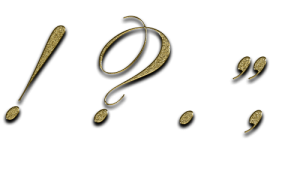Navigating the Punctuation Maze: How to Dodge Common Mistakes
Common Punctuation Mistakes
 Punctuation, the unsung hero of written communication, plays a critical role in conveying meaning as well as maintaining clarity. However, navigating the labyrinth of punctuation rules can be a challenge, leading many writers into common pitfalls. In this article, we will dissect frequently made punctuation mistakes and provide practical tips, along with illustrative examples, in order to help writers enhance their punctuation skills and elevate the quality of their written work.
Punctuation, the unsung hero of written communication, plays a critical role in conveying meaning as well as maintaining clarity. However, navigating the labyrinth of punctuation rules can be a challenge, leading many writers into common pitfalls. In this article, we will dissect frequently made punctuation mistakes and provide practical tips, along with illustrative examples, in order to help writers enhance their punctuation skills and elevate the quality of their written work.
Misusing the Apostrophe: The Possessive Predicament
Apostrophes have two main functions: possession and contraction.
One of the most prevalent punctuation mistakes involves the misuse of apostrophes, particularly in possessive forms. For example, “the cat’s toy”. However, an exception to this rule, and one of the most confusing, is “its” versus “it’s”. For example, “the cat plays with its toy”. In this case, “its” (without an apostrophe) is the possessive form while “it’s” (with an apostrophe) is a contraction for “it is” or “it has”.
Incorrect: The dog wagged it’s tail.
Correct: The dog wagged its tail.
The easiest way to remember when to use “it’s” or “its”: if “it is” or “it has” does not make sense in the sentence, you should most probably use “its”.
Overindulgence in Commas: The Comma Splice Conundrum
Misusing commas, especially in creating comma splices, is a common error. Improperly joining two independent clauses with a comma results in a comma splice. Therefore, consider using a coordinating conjunction or separating the clauses into distinct sentences to rectify this.
Incorrect: The sun was setting, the sky was painted in hues of pink and orange.
Correct: The sun was setting, and the sky was painted in hues of pink and orange.
Neglecting the Oxford Comma: A List’s Silent Saviour
People often neglect the Oxford comma (also known as the serial comma), placed before the conjunction in a list, causing confusion. For this reason, its usage is critical for clarity, preventing ambiguity in lists of three or more items.
Incorrect: I had lunch with my parents, a chef and a nutritionist.
Correct: I had lunch with my parents, a chef, and a nutritionist.
This is a prime example of ambiguity when omitting the Oxford comma. The first sentence implies that your parents are a chef and a nutritionist while the second sentence presents these as three separate entities – your parents, a chef, and a nutritionist.
The Dangling Modifier Dilemma: Tying Up Loose Ends
Dangling modifiers occur when the intended subject of a modifying phrase is unclear or missing. In order to avoid confusion, ensure that the subject being modified is clearly stated in the sentence.
Incorrect: After finishing the book, the television was turned off.
Correct: After finishing the book, she turned off the television.
Dash Differences: Misunderstanding the Hypen, En Dash, and Em Dash
Confusion between hyphens, en dashes, and em dashes is a common pitfall. Use a hyphen to connect words, an en dash to denote a range, and an em dash to indicate a break in thought or for emphasis.
Hyphen: She was well-known in the community.
En Dash: The dog was 5-6 years old.
Em Dash: He asked – no, demanded – to be given the promotion.
Ignoring the Colon’s Purpose: Introduction and Emphasis
People often misuse the colon when they misunderstand its function as an introducer or emphasiser. Use colons to introduce lists or explanations or to emphasise a point.
Incorrect: She had three goals in mind, success, happiness, and balance.
Correct: She had three goals in mind: success, happiness, and balance.
Excessive Exclamation Points: Proceed with Caution
While exclamation points convey excitement or urgency, their overuse dilutes their impact. Therefore, reserve them for situations that genuinely call for emphasis or strong emotion.
Incorrect: The party was amazing!!!!!!!!
Correct: The party was amazing!
 Punctuation is the silent conductor orchestrating the symphony of written language. By identifying and rectifying common punctuation marks, writers can elevate the clarity and effectiveness of their communication. Remember, mastering punctuation is an ongoing journey and thus, with each correction, writers refine their skills and enhance the impact of their written expression.
Punctuation is the silent conductor orchestrating the symphony of written language. By identifying and rectifying common punctuation marks, writers can elevate the clarity and effectiveness of their communication. Remember, mastering punctuation is an ongoing journey and thus, with each correction, writers refine their skills and enhance the impact of their written expression.
However, if you’re unsure of whether you’re making punctuation mistakes, contact us for our proofreading and editing services. We also ensure correct punctuation in relevant typing projects and transcription.





 Apostrophes, those small but powerful punctuation marks, play a crucial role in written language. However, their usage is often a source of confusion and frustration for many writers. In this article, we will delve into the intricacies of apostrophe usage, exploring the rules that govern their placement and the possible variations that may occur.
Apostrophes, those small but powerful punctuation marks, play a crucial role in written language. However, their usage is often a source of confusion and frustration for many writers. In this article, we will delve into the intricacies of apostrophe usage, exploring the rules that govern their placement and the possible variations that may occur.